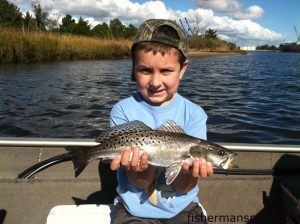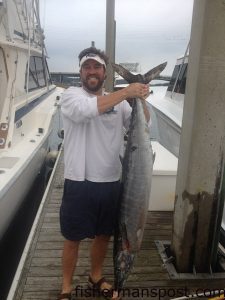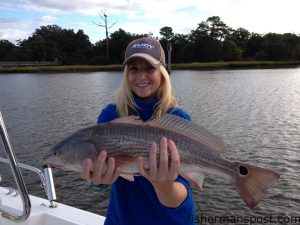Wrightsville Beach Winter 2013-2014

Hunter Cain, of Wilmington, with his first speckled trout, a 17″ fish that bit a live shrimp in the Cape Fear River near Wilmington.
Tex, of Tex’s Tackle, reports that there’s been a solid speckled trout bite in the area recently, with most of the larger fish coming from the inlets and the Cape Fear River. The specks are biting hardbaits (like MirrOlure MR17 and 18s) and soft plastics (like Vudu and Savage shrimp, Billy Bay Halo Shads, and Gulp baits).
Red drum will be looking for meals around inshore docks, in the creeks, and on the flats over the winter, and anglers who can find the schools of fish can often have some banner days. A variety of soft plastic baits will attract attention from the reds, but when it gets colder and they get more lethargic, live mud minnows and cut shrimp or mullet are better options.
Surf casters are hooking some sea mullet and bluefish on bottom rigs around Wrightsville.
Those boaters who’ve made it offshore recently are reporting some king mackerel in the 20 mile range, and the fish should be moving offshore as the waters cool. They’ll spend the winter wherever they can find water temperatures in the upper-60’s and concentrations of baitfish, usually in the 40 mile range. Anglers can fool the winter kings with dead cigar minnows, Drone spoons, and other trolling baits.

Hanes Hoffman with a wahoo that struck a ballyhoo while he was trolling the Gulf Stream off Wrightsville Beach with Capt. Ken Upton and mate Ken Cofer on the “Gamekeeper.”
Bottom fishermen are connecting with some gag grouper in the 20-30 mile range, where anglers should be able to find them until the season closes at the end of the year.
Not many boats have made it to the Gulf Stream all winter, but there should be chances at wahoo and blackfin tuna for most of the winter as long as there’s warm water on the break. Trolling skirted ballyhoo for the wahoo and smaller lures for the blackfins is the way to go, and anglers can also tempt the blackfins to take vertical jigs and topwater poppers when they’re schooled up and feeding.
Jim, of Plan 9 Charters, reports that there’s been a good striped bass and red drum bite in the Cape Fear River around downtown Wilmington. The fish are feeding around shoreline structure and ledges and drop-offs. White soft plastic baits like Zoom Flukes on 1/4 oz. jigheads are top choices for both the reds and stripers.
Small speckled trout are feeding up and down the ICW and biting a wide variety of lures, but it’s tough to find keepers amidst all the short fish.
Trevor, of ProFishNC Charters, reports that anglers are starting to see some tautog showing up around the Masonboro jetties, and the bite should get better as the water continues to cool off. Cut shrimp and pieces of crab are tough for the crustacean-lovers to turn down.

Lori Little with her first slot red drum, a 22″ fish that bit a Carolina-rigged menhaden in Bradley Creek.
Some schools of red drum are feeding around deeper docks, boat basins, and mud banks, where anglers may be able to find them all winter. Shrimp, cut baits, and slowly worked Gulps or other soft plastics will tempt bites from the schooled-up reds.
And there’s been a good speckled trout bite in the Cape Fear River, with unusually salty water producing good fishing nearly to Wilmington. Soft plastics on light jigheads are fooling most of the specks.
Rick, of Living Waters Guide Service, reports that the winter-time offshore jigging is heating up. African pompano are showing up at structure along the break, where they’re feeding alongside amberjacks and a host of other predators. Vertical jigging around schools of fish that anglers mark on the sounder in 150’ of water and deeper is the way to put them in the boat.
Blackfin tuna are also feeding at local Gulf Stream hotspots. They’ll pounce on smaller trolling lures, vertical jigs, and topwater plugs worked around fish that anglers spy on the sounder or see feeding on the surface.
Scattered wahoo should be feeding in the same areas for much of the winter as well, and they will take an interest in ballyhoo paired with skirted lures or a variety of baitless artificials.
Steve, of Johnnie Mercer’s Pier, reports that bottom fishermen are hooking some sea mullet, puffferfish, and bluefish from the pier while baiting up with shrimp and cut baits. Cooler weather will likely slow the bluefish action, but it should also produce a better puffer bite.
Dogfish are also starting to make their winter appearance, in plenty of time for the pier’s annual Dogfish Tournament on January 25.
